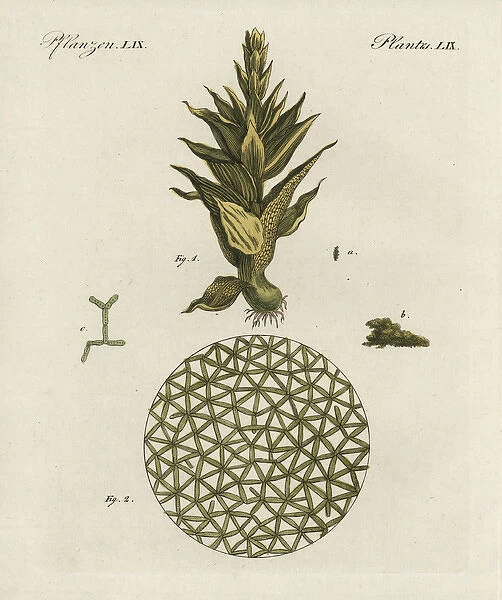Common moss, Phascum cuspidatum, and pond algae
![]()

Wall Art and Photo Gifts from Mary Evans Picture Library
Common moss, Phascum cuspidatum, and pond algae
Common moss, Phascum cuspidatum, and pond algae.. Magnified image of common moss, Phascum cuspidatum 1, and microscopic enlargment of pond algae, Hydrodictyon utriculatum 2. handcolored copperplate engraving from Bertuchs -Bilderbuch fur Kinder- (Picture Book for Children), Weimar, 1798. Friedrich Johann Bertuch (1747-1822) was a German publisher and man of arts most famous for his 12-volume encyclopedia for children illustrated with 1, 200 engraved plates on natural history, science, costume, mythology, etc. published from 1790-1830
Mary Evans Picture Library makes available wonderful images created for people to enjoy over the centuries
Media ID 14206630
© Florilegius / Mary Evans
Bilderbuchfurkinder Friedrichbertuch Microscopic Picturebookforchildren
EDITORS COMMENTS
This handcolored copperplate engraving, taken from Friedrich Johann Bertuch's "Bilderbuch fur Kinder" or "Picture Book for Children," published in Weimar in 1798, offers a magnified and intricately detailed view of the natural world. The image, titled "Common Moss, Phascum cuspidatum, and Pond Algae," showcases two distinct elements of aquatic ecosystems: the common moss, Phascum cuspidatum, and the microscopic pond alga Hydrodictyon utriculatum. The common moss, Phascum cuspidatum, depicted in the engraving, is a type of moss commonly found in damp areas, including along the edges of ponds and other bodies of water. Its small, green, and pointed leaves are arranged in a rosette formation, and it is known for its ability to absorb water and nutrients directly from the air and rain. In contrast, the microscopic enlargement of pond alga, Hydrodictyon utriculatum, reveals the intricate details of a single cell. This type of alga is characterized by its unique, hollow, and spherical shape, which resembles a small, floating bladder. The cells are covered in tiny, hair-like structures called cilia, which help them move and filter water for nutrients. Friedrich Johann Bertuch, the German publisher and man of arts, was renowned for his 12-volume encyclopedia for children, which was illustrated with 1,200 engraved plates on various subjects, including natural history, science, costume, and mythology. This image, along with the others in the series, served to educate and inspire the young minds of the time, fostering a deep appreciation for the wonders of the natural world.
MADE IN AUSTRALIA
Safe Shipping with 30 Day Money Back Guarantee
FREE PERSONALISATION*
We are proud to offer a range of customisation features including Personalised Captions, Color Filters and Picture Zoom Tools
SECURE PAYMENTS
We happily accept a wide range of payment options so you can pay for the things you need in the way that is most convenient for you
* Options may vary by product and licensing agreement. Zoomed Pictures can be adjusted in the Cart.


